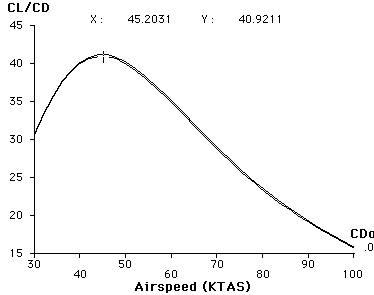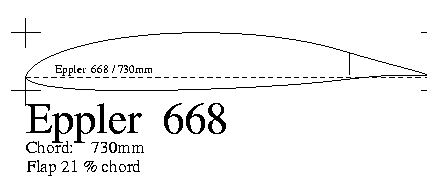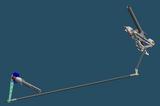![]() To a glider pilot the Graal will look familiar. Its size, controls and cockpit accommodation are like those of a modern glider. Flying it should be a subtle merge of a recent "plastic" glider and a good "wood and linen". Indeed, aspect ratio, airfoil specifications and thickness are conforming to modern criteria, whereas wing load, limited by UL rules is about half those of most loaded recent sailplanes. Quite close therefore to, say, a K6.
To a glider pilot the Graal will look familiar. Its size, controls and cockpit accommodation are like those of a modern glider. Flying it should be a subtle merge of a recent "plastic" glider and a good "wood and linen". Indeed, aspect ratio, airfoil specifications and thickness are conforming to modern criteria, whereas wing load, limited by UL rules is about half those of most loaded recent sailplanes. Quite close therefore to, say, a K6.

![]() If aerodynamic specifications do not allow to compete against loaded sailplane at high speed, they show on the other hand a very good sink rate at minimum speed, typical of good climber gliders.
If aerodynamic specifications do not allow to compete against loaded sailplane at high speed, they show on the other hand a very good sink rate at minimum speed, typical of good climber gliders.
A majority of pilots don't use much the right side of the polar curve, due to lack of training or to weak conditions. In fact the Graal compromise fit quite well everyday practice of "pleasure" soaring. Inter-thermal speed make the difference if one can quickly contact and center lift, which is much more easy, given a sink rate, with a slower glider circling tighter. We find again the question "to ballast or not" and, with all due deference to water ballast fan, it's often easier to get the best from a good climber glider (on this subject read the history page).
L/D curve vs speed.
Warning: speed are in knot on this curve.

![]() But we still want to go forward and to get a flight speed allowing good cross country flights, the Graal feature a modern airfoil (Eppler E668), with a relatively low lift coefficient (lower lift means higher speed) and a good L/D. With a thickness of 14% and
But we still want to go forward and to get a flight speed allowing good cross country flights, the Graal feature a modern airfoil (Eppler E668), with a relatively low lift coefficient (lower lift means higher speed) and a good L/D. With a thickness of 14% and
root chord of 730mm the wing is very thin, thank to the strength of his carbon spar.

![]() Wings are fitted with flaperons combining functions of flaps and ailerons and running on all wingspan. For them not running out the nominal specification of the airfoil (+10°, -7°), a special control mixer has been build. Its key principle is to keep the differential value of angle between the two flaperons given by a stick movement, while moving the neutral point of this action as a function of flaps control position.
Wings are fitted with flaperons combining functions of flaps and ailerons and running on all wingspan. For them not running out the nominal specification of the airfoil (+10°, -7°), a special control mixer has been build. Its key principle is to keep the differential value of angle between the two flaperons given by a stick movement, while moving the neutral point of this action as a function of flaps control position.
Example : both flaps are in maximum positive position due to flaps control (thermal circling). A lateral stick action induce a negative move on the inside flaperon (normal), but this move is twice the value it would have been in "flat" flap position, for the outside flaperon, already in lowest position, stay still. If flaps Were in medium positive position (+5°), outside flaperon would go down to low position while inside one would go up. In fine, a full lateral stick action bring flaperons to +10°/-7° position whatever the "flaps" control position may be.
![]() Airbrakes, mandatory for this category of aspect ratio, are "schemp-hirth" type and come out the upper surface only.
Airbrakes, mandatory for this category of aspect ratio, are "schemp-hirth" type and come out the upper surface only.
![]() Landing gear is one wheel and retractable.
Landing gear is one wheel and retractable.
![]() The engine is in fixed position inside fuselage. The König 3 cylinders is now replaced by a twin cylinder RDM200.
The engine is in fixed position inside fuselage. The König 3 cylinders is now replaced by a twin cylinder RDM200.
It lay behind the pilot, very close of plane CG. Two trapdoors ensure airflow needed for cooling. These are closed with a small gear when the motor is off and cool.
A driving shaft transmit power to the tail propulsive propeller. This one fold under drag force (see photo), centrifugal force open it in case of engine restart.
![]() Driving shaft always raise up many questions and comments. Let's resume the subject :
Driving shaft always raise up many questions and comments. Let's resume the subject :
The big problem they set is the risk of resonant oscillation induced by unavoidable equilibrium defect (center of gravity is not on rotation axis). A driving shaft as any solid has its own vibration frequency function of its dimensions (length, quadratic momentum), of its mass and of mechanical specification (elasticity modulus). Once computed this frequency one have two choices :
--- chose a rotation speed significantly under the critic frequency, where CG lag produce a flexion increasing with unbalance and speed. To stay under critic frequency, it may be necessary to insert intermediate bearing.
--- on the contrary if the shaft run at a speed substantially higher than the critic frequency, CG come naturally an line up on rotating axis, like a spinning-top. Shaft is acting like a gyroscopic stabilisator and its flexion is constant. Turbine shaft running at very high speed use this property. The difficulty, here, is to calculate a shaft with enough strength to drive engine power but still flexible to have a critic frequency significantly lower than the minimum operating speed. For high power engine this equation is hard to solve. Graal shaft, even when engine throttle down, is stable and indeed act as a stabilisator for König typical hiccups ( 1 ).
![]() Rocket parachute is one very good breakthrough of ultralight world. The goal is to bring down to earth, at reasonable speed, the glider and its pilot. No more pilot ejection procedure, faster and safer. The Graal ultralight frame can't offer the same protective shield against crash that heavy plastic gliders, so the parachute is here to suppress most of bad shock (spinning, bad outlanding). Under the seat there is a crash-box to absorb energy and protect the pilot.
Rocket parachute is one very good breakthrough of ultralight world. The goal is to bring down to earth, at reasonable speed, the glider and its pilot. No more pilot ejection procedure, faster and safer. The Graal ultralight frame can't offer the same protective shield against crash that heavy plastic gliders, so the parachute is here to suppress most of bad shock (spinning, bad outlanding). Under the seat there is a crash-box to absorb energy and protect the pilot.
![]() Due to machine size, one must use a trailer for road carrying. Thank to the very low empty weight of Graal, its a light trailer with gear for (dis)assembling by a person alone.
Due to machine size, one must use a trailer for road carrying. Thank to the very low empty weight of Graal, its a light trailer with gear for (dis)assembling by a person alone.
![]() Fellows from hang-gliding, paragliding or ultralight, waiting for an affordable autonomous machine to change their flight domain should have understood after reading this page they have to learn flying a glider. Unlike some other ultralight gliders the Graal is designed for real cross-country soaring. Therefore, using correctly and safely flaps, retractable landing gear and launching engine, not talking of sensitive controls of sailplanes ask for a minimum of training.
Fellows from hang-gliding, paragliding or ultralight, waiting for an affordable autonomous machine to change their flight domain should have understood after reading this page they have to learn flying a glider. Unlike some other ultralight gliders the Graal is designed for real cross-country soaring. Therefore, using correctly and safely flaps, retractable landing gear and launching engine, not talking of sensitive controls of sailplanes ask for a minimum of training.
As soon as gotten the required skill they should find with the Graal the beloved freedom of flight in a new range of performances.
____________________________________________________
(1) König engine has 3 radial cylinder with 3 crank-arms on one crank-pin. There is only one crankshaft intake chamber, not very useful for a 2 stroke engine. So there are 2 rotating disks dividing this chamber in 3 parts. When throttle down, air tightness is poor and engine speed not very stable. At useful speed its very effective and 120° spark spacing produce very few vibrations.